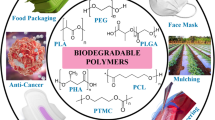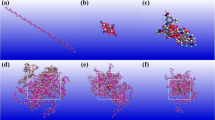Abstract
New series of thermo-pH multi-responsive terpolymers were fabricated. Cationic acrylate monomer was synthesized and named by [2-((ditert-butylamino)methyl)-4-formyl-6-methoxyphenyl acrylate] and abbreviated as (DTBAVA). 1H NMR and 13C NMR investigated the new compounds and FT IR. The new terpolymers were fabricated by the free radical polymerization of N-isopropylacrylamide NIPAAm, 10 mol% N, N-dimethylacrylamide and 5, 10, and 20 mol% DTBAVA. The investigation process involved the chemical method such as 1H NMR and FT IR; physical methods for the solid terpolymers as glass temperature by DSC, polymer degradation by TGA, and polymer crystallinity via XRD. GPC was performed for molecular weights and dispersity; contact angles for identifying the hydrophilic or hydrophobic terpolymers solutions. The lower critical solution temperatures Tc,s, and cloud points Cp,s of terpolymers were recorded considering the impact of pH solutions and the concentrations of different sodium salts of (SO4−2, Cl−1, and SCN−1) in the Hofmeister series; turbidity measurements were used via UV/vis spectroscopy and micro-DSC. In a new optimization study, we will use these terpolymers in the post-polymerization with biomolecules such as chitosan, protein, and amino acids via Schiff base.
Graphical Abstract

















Similar content being viewed by others
References
Abdelaty MSA (2020) Influence of vanillin acrylate and 4-acetylphenyl acrylate hydrophobic functional monomers on phase separation of N-isopropylacrylamide environmental terpolymer: fabrication and characterization. Polym Bull 77:2905–2922. https://doi.org/10.1007/s00289-019-02890-0
Abdelaty MSA (2021) Trends in the phase separation temperature optimization of a functional and thermo-pH responsive terpolymer of poly (N-isopropylacrylamide-co-N-(2-(dimethylamino)ethyl) acrylamide-co-vanillin Acrylate). J Polym Environ. https://doi.org/10.1007/s10924-021-02096-4
Herbert M, Nikita TT (2022) Stimuli-responsive polymers and their applications in separation science. React Funct Polym 175:105282. https://doi.org/10.1016/j.reactfunctpolym.2022.105282
Fang FF, Lee BM, Choi HJ (2010) Electrorheologically intelligent polyaniline and its composites. Macromol Res 18:99–112. https://doi.org/10.1007/s13233-009-0198-5
Abdelaty MSA, Kuckling D (2016) Synthesis and characterization of new functional photo cross-linkable smart polymers containing vanillin derivatives. Gels 2:1–13. https://doi.org/10.3390/gels2010003
Chuan-Ling Zhang F-H, Cao J-L, Zhi-Long Yu, Ge J, Yang Lu, Wang Z-H, Shu-Hong Yu (2017) Highly, stimuli-responsive au nanorods/poly(N-isopropylacrylamide) (PNIPAM) composite hydrogel for smart switch. ACS Appl Mater Interfaces 9(29):24857–24863. https://doi.org/10.1021/acsami.7b05223
Fabrice O, Mohamad T, Noureddine L, Émilie G, Denis M, Abdelhamid E (2021) pH-sensitive polymers: classification and some fine potential applications. Polym Adv Technol 32(4):1455–1484. https://doi.org/10.1002/pat.5230
Ilgin P, Ozay H, Ozay O (2020) Synthesis and characterization of pH responsive alginate based-hydrogels as oral drug delivery carrier. J Polym Res 27:251. https://doi.org/10.1007/s10965-020-02231-0
Abdelaty MSA (2021) A Facile Method for the Preparation of Hydrophilic-Hydrophobic Functional Thermo-pH Responsive Terpolymers Based on Poly (NIPAAm-co-DMAA-co-DMAMVA) and Post-polymerization. J Polym Environ 29:3227–3241. https://doi.org/10.1007/s10924-021-02117-2
Ghilan A, Chiriac AP, Nita LE et al (2020) Trends in 3D printing processes for biomedical field: opportunities and challenges. J Polym Environ 28:1345–1367. https://doi.org/10.1007/s10924-020-01722-x
Low SC, Ng QH, Tan LS (2019) Study of magnetic-responsive nanoparticle on the membrane surface as a membrane antifouling surface coating. J Polym Res 26:70. https://doi.org/10.1007/s10965-019-1734-4
Karimi M, Sahandi Zangabad P, Ghasemi A, Amiri M, Bahrami M, Malekzad H, Ghahramanzadeh Asl H, Mahdieh Z, Bozorgomid M, Ghasemi A, Boyuk RT, Hamblin MR (2016) Temperature-responsive smart nanocarriers for delivery of therapeutic agents: applications and recent advances. ACS Appl Mater Interfaces 8(33):21107–21133. https://doi.org/10.1021/acsami.6b00371
Schild HG (1992) Poly(N-isopropylacrylamide): experiment, theory and application. Prog Polym Sci 17(2):163–249. https://doi.org/10.1016/0079-6700(92)90023-R
Halperin A, Kröger M, Winnik FM (2015) Poly(N-isopropylacrylamide) phase diagrams: fifty years of research. Angew Chem Int Ed Engl 54(51):15342–15367. https://doi.org/10.1002/anie.201506663
Heskins M, Guillet JE (1968) Solution properties of Poly(N-isopropylacrylamide). J Macromol Sci Part A 2(8):1441–1455. https://doi.org/10.1080/10601326808051910
Minwoo N, Sunah K, Yeongbong M, So JC, Jeongseon P, Jannick K, Ji-Hun S, Yan L (2016) Upper critical solution temperature (UCST) phase transition of halide salts of branched polyethylenimine and methylated branched polyethylenimine in aqueous solutions. Chem Commun 52:509–512. https://doi.org/10.1039/C5CC08005C
Jukka N, Heikki T (2017) How to manipulate the upper critical solution temperature (UCST)? Polym Chem 8:220–232. https://doi.org/10.1039/C6PY01612J
Lanzalaco S, Armelin E (2017) Poly(N-isopropylacrylamide) and copolymers: a review on recent progresses in biomedical applications. Gels 3(4):36
Abdelaty MSA (2021) Poly(N-isopropylacrylamide-co-2-((diethylamino)methyl)-4-methylphenyl acrylate) thermo-ph responsive copolymer: trend in the lower critical solution temperature optimization of Poly (N-isopropyylacrylamide). J Polym Res 28:213. https://doi.org/10.1007/s10965-021-02574-2
Abdelaty MSA (2020) The Effect Hydrophilic/Hydrophobic Interaction of 2-((Dimethylamino)methyl)-4-formyl-6 methoxyphenyl Acrylate and 4-Acetylphenyl Acrylate Monomers on the Phase Transition Temperature of N-isopropylacrylamide Terpolymers. J Polym Environ 28:2584–2598. https://doi.org/10.1007/s10924-020-01790-z
David JM, Meri A, Christine B, Vikram SR, George PS, Joel FH, Gil G (2022) Thermoresponsive Poly(N-isopropylacrylamide) grafted from cellulose nanofibers via silver-promoted decarboxylative radical polymerization. Biomacromol 23(4):1610–1621. https://doi.org/10.1021/acs.biomac.1c01444
Abdelaty MSA (2018) Preparation and characterization of new environmental functional polymers based on vanillin and N-isopropylacrylamide for post polymerization. J Polym Environ 26:636–646. https://doi.org/10.1007/s10924-017-0960-2
Avraham H, Martin K, FranÅoise MW (2015) Poly(N-isopropylacrylamide) phase diagrams: fifty years of research. Angew Chem Int Ed 54:15342–15367. https://doi.org/10.1002/anie.201506663
Abdelaty MSA (2018) Environmental functional photo-cross-linked hydrogel bilayer thin films from vanillin (Part 2): temperature responsive layer A, functional, temperature and pH layer B. Polym Bull 11:4837–4858. https://doi.org/10.1007/s00289-018-2297-y
Abdelaty MSA (2020) The Influence of vanillin acrylate derivative on the phase separation temperature of environmental photo-cross-linked N-isopropylacrylamide copolymer and hydrogel thin films. J Polym Environ 28:2599–2615. https://doi.org/10.1007/s10924-020-01793-w
Choi C, Jang MK, Nah JW (2007) Preparation and characterization of nanoparticles using poly(N-isopropylacrylamide)-poly(ε-caprolactone) and poly(ethylene glycol)-poly(ε-caprolactone) block copolymers with thermosensitive function. Macromol Res 15:623–632. https://doi.org/10.1007/BF03218942
Xu F, Yan TT, Luo YL (2011) Synthesis and micellization of thermosensitive PNIPAAm-b-PLA amphiphilic block copolymers based on a bifunctional initiator. Macromol Res 19:1287–1295. https://doi.org/10.1007/s13233-011-1209-x
Xiaowei W, Yaxuan G, Qi L, Yapeng X, Yifan S, Zheran W, Mingyu X, Ji L, Dongkai W (2022) Synergistic chemo-photothermal cancer therapy of pH-responsive polymeric nanoparticles loaded IR825 and DTX with charge-reversal property. Colloids Surf, B 209(2):112164. https://doi.org/10.1016/j.colsurfb.2021.112164
Orakdogen N, Celik T (2016) Ion-stimuli responsive dimethylaminoethyl methacrylate/hydroxyethyl methacrylate copolymeric hydrogels: mutual influence of reaction parameters on the swelling and mechanical strength. J Polym Res 23(57):1–17. https://doi.org/10.1007/s10965-016-0946-0
Kyobum K, William CWC, Yunhoe H, Yadong W (2016) Polycations and their biomedical applications. Prog Polym Sci 60:18–50. https://doi.org/10.1016/j.progpolymsci.2016.05.004
Reyes-Ortega, F (2014) pH-responsive polymers: properties, synthesis and applications. In: Aguilar MR, Román JS, Smart Polymers and their Applications, Woodhead Publishing, pp 45–92. https://doi.org/10.1533/9780857097026.1.45.
Gupta P, Purwar R (2020) Electrospun pH responsive poly (acrylic acid-co- acrylamide) hydrogel nanofibrous mats for drug delivery. J Polym Res 27:296. https://doi.org/10.1007/s10965-020-02236-9
Yoshida E (2018) Preparation of giant vesicles containing quaternary ammonium salt of 2-(dimethylamino)ethyl methacrylate through photo nitroxide-mediated controlled/living radical polymerization-induced self-assembly. J Polym Res 25:109. https://doi.org/10.1007/s10965-018-1509-3
Annika H, Juan MG, Gabriel SL (2018) Use of pH Gradients in Responsive Polymer Hydrogels for the Separation and Localization of Proteins from Binary Mixtures. Macromolecules 51(20):8205–8216. https://doi.org/10.1021/acs.macromol.8b01876
Najafipour A, Mahdavian AR, Aliabadi HS et al (2020) Dual thermo- and pH-responsive poly(N-isopropylacrylamide-co-(2-dimethylamino) ethyl methacrylate)-g-PEG nanoparticle system and its potential in controlled drug release. Polym Bull 77:3129–3142. https://doi.org/10.1007/s00289-019-02895-9
Siddique AB, An JW, Kim HJ et al (2017) Synthesis of dual stimuli-responsive polymers through atom transfer radical mechanism in aqueous media. Macromol Res 25:70–78. https://doi.org/10.1007/s13233-017-5004-1
Adeli F, Abbasi F, Babazadeh M et al (2022) Thermo/pH dual-responsive micelles based on the host–guest interaction between benzimidazole-terminated graft copolymer and β-cyclodextrin-functionalized star block copolymer for smart drug delivery. J Nanobiotechnol 20:91. https://doi.org/10.1186/s12951-022-01290-3
Abdelaty MSA (2018) Environmental functional photo-cross-linked hydrogel bilayer thin films from vanillin. J Polym Environ 26:2243–2256. https://doi.org/10.1007/s10924-017-1126-y
Abdelaty MSA (2018) Poly(N-isopropylacrylamide-co-2-((diethylamino)methyl)-4 formyl-6-methoxyphenylacrylate) environmental functional copolymers: synthesis, characterizations, and grafting with amino acids. Biomolecules 8:138
Abdelaty MSA (2019) Layer by layer photo-cross-linked environmental functional hydrogel thin films based on vanillin: part 3. J Polym Environ 27:1212–1225. https://doi.org/10.1007/s10924-019-01421-2
Maxence F, Emilie D, Vincent B, Rémi A, Sylvain C, Bernard B (2014) Vanillin, a promising biobased building-block for monomer synthesis. Green Chem 16:1987–1998. https://doi.org/10.1039/C3GC42613K
Robin K, Volkmar MS, Carsten C, Dominik M, Detlef S, Jens T (2021) Electrochemical synthesis of biobased polymers and polymer building blocks from vanillin. RSC Adv 11:8970–8985. https://doi.org/10.1039/D1RA00649E
Shen Z, Terao K, Maki Y, Dobashi T, Ma G, Yamamoto T (2006) Synthesis and phase behavior of aqueous poly(N-isopropylacrylamide-co-acrylamide), poly(N-isopropylacrylamide-co-N, N-dimethylacrylamide) and poly(N-isopropylacrylamide-co-2-hydroxyethyl methacrylate). Colloid Polym Sci 284(9):1001–1007. https://doi.org/10.1007/s00396-005-1442-y
Akhmetzhan A, Myrzakhmetova N, Amangeldi N, Kuanyshova Z, Akimbayeva N, Dosmaganbetova S, Toktarbay Z, Longinos SN (2021) A short review on the N,N-dimethylacrylamide-based hydrogels. Gels 7(4):234. https://doi.org/10.3390/gels7040234
Yinlei L, Shuoqi W, Sheng S, Yaoheng L, Yisheng X, Huawen H, Jie L, Haichen Z, Guangji L (2021) Highly tough and rapid self-healing dual-physical crosslinking poly(DMAA-co-AM) hydrogel. RSC Adv 11:32988–32995. https://doi.org/10.1039/D1RA05896G
Hofmeister F (1888) Zur Lehre von der Wirkung der Salze. Arch Exp
Von Hippel PH, Schleich T (1969) Ion effects on the solution structure of biological macromolecules. Acc Chem Res 2:257. https://doi.org/10.1021/ar50021a001
Zhang Y, Cremer PS (2006) Interactions between macromolecules and ions: the Hofmeister series. Curr Opin Chem Biol 10:658. https://doi.org/10.1016/j.cbpa.2006.09.020
Kunz W, Lo Nostro P, Ninham BW (2004) The present state of affairs with Hofmeister effects. Curr Opin Colloid Interface Sci 9:1–18. https://doi.org/10.1016/j.cocis.2004.05.004
Zhang Y, Furyk S, Sagle LB, Cho Y, Bergbreiter DE, Cremer PS (2007) Effects of hofmeister anions on the LCST of PNIPAM as a function of molecular weight. J Phys Chem C 111:8916. https://doi.org/10.1021/jp0690603
Shirin F, Nodar A-M, Kaizheng Z, Anna-Lena K, Bo N (2012) Effects of Hofmeister anions on the flocculation behavior of temperature-responsive poly(N-isopropylacrylamide) microgels. Colloid Polym Sci 290:1609–1616. https://doi.org/10.1007/s00396-012-2689-8
Maria CMC, Sérgio MCS, Filipe EA (2015) Adjusting the low critical solution temperature of poly(N-isopropyl acrylamide) solutions by salts, ionic surfactants and solvents: a rheological study. J Mol Liquids 210:113–118. https://doi.org/10.1016/j.molliq.2015.02.008
Liusheng Z, Jianhua H, Changchun W, Shoukuan F, Meifang L (2002) The effect of electrolyte on the colloidal properties of poly(N-isopropylacrylamideco-dimethylaminoethylmethacrylate) microgel latexes. Colloid Polym Sci 280:1116–1121. https://doi.org/10.1007/s00396-002-0734-8
Younhee C, Yanjie Z, Trine C, Laura BS, Ashutosh C, Cremer PS (2008) Effects of hofmeister anions on the phase transition temperature of elastin-like polypeptides. J Phys Chem B 112:13765–13771
Pérez E, Bello A, Pereña JM (1988) Substituent effect on the glass transition temperature of polyoxetanes. Polym Bull 20:291–296. https://doi.org/10.1007/BF00261983
Doumeng M, Makhlouf L, Berthet F, Marsan O, Delbé K, Denape J, Chabert F (2021) A comparative study of the crystallinity of polyetheretherketone by using density, DSC, XRD, and Raman spectroscopy techniques. Polym Testing 93:106878. https://doi.org/10.1016/j.polymertesting.2020.106878
Law KY (2014) Definitions for hydrophilicity, hydrophobicity, and superhydrophobicity: getting the basics right. J Phys Chem Lett 20:686–688. https://doi.org/10.1021/jz402762h
Acknowledgements
I want to thank the University of Paderborn.
Author information
Authors and Affiliations
Corresponding author
Ethics declarations
Conflict of interest
The authors declare that there are no conflict of interest regarding the publication of this paper.
Additional information
Publisher's Note
Springer Nature remains neutral with regard to jurisdictional claims in published maps and institutional affiliations.
Rights and permissions
About this article
Cite this article
Abdelaty, M.S.A. The Influence of pH/Salt Concentrations on Tuning Lower Critical Solution Temperature of Poly(NIPAAm-co-DMAA-co-DTBAVA) Multi-Environmentally Terpolymer. J Polym Environ 30, 4130–4145 (2022). https://doi.org/10.1007/s10924-022-02502-5
Accepted:
Published:
Issue Date:
DOI: https://doi.org/10.1007/s10924-022-02502-5




